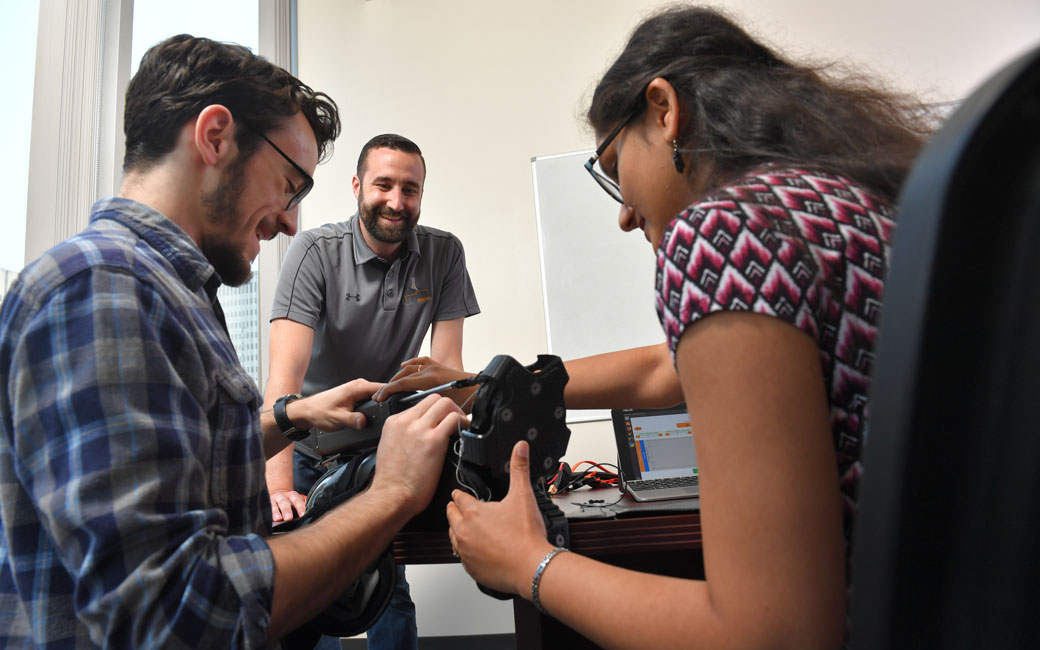Taking risks with robotic rehabilitation
Brad Hennessie ’09, CEO of NextStep Robotics, seeks to help stroke survivors
By Kyle Hobstetter on August 8, 2019

When Brad Hennessie ’09 came to Towson University, he wanted to be a physical therapist.
Now, over a decade after graduating with a bachelor’s degree in kinesiology, he’s developing a rehabilitation tool that will help physical therapists treat stroke victims.
Hennessie is CEO and co-founder of NextStep Robotics, a Baltimore-based startup company that is developing a device to help treat foot drop.
Approximately 30 percent of stroke survivors suffer from foot drop, a mobility disability affecting people who can’t lift their large toe while walking, thus facing a high risk of falling.
The Columbia, Maryland, native, who also served as a paratrooper in the Maryland Army National Guard, admits he’s a bit of a risk taker. But even he couldn’t imagine being in this position after leaving TU.
“I like adrenaline,” Hennessie laughs. “This is a different type of adrenaline, the type that wakes you up at two in the morning in a cold sweat.
“We’ve made some remarkable progress in a short amount of time that we’ve been at it. And that’s largely because of that fact that we’ve had 10 years of clinical data showing this works. I never would have taken this risk if I hadn’t actually seen patients’ lives greatly improve from using the laboratory version of the device.”
According to the National Stroke Association, there are over 7 million stroke survivors in the United States and over 800,000 new stokes per year.
Hennessie and the group at NextStep Robotics provide a foot drop rehabilitation tool to physical therapy clinics that can offer personalized robotic therapy through adaptive software with a personalized assist-as-needed approach to he.
Since its inception over two years ago, NextStep Robotics has been awarded several grants, including one from the TEDCO Maryland Innovation Initiative grant, as well as a grant from the Maryland Momentum Fund.
NextStep Robotics received other funding as well, including an investor who suffered from foot drop caused by a stroke. Through use of the group’s laboratory prototype, the man had his first bit of ankle movement in 17 years.
“It’s empowering to see that, especially with these people who were told there is nothing out there for them,’” Hennessie says. “They are given a brace and told they had to wear this for the rest of their lives.
“And with the concept of neuroplasticity, and the changes in the field toward it, that's slowly starting to change a little. But it's going to take devices like ours, which are affordable to the majority of clinics, to be able to really take that into a much more serious practice.”
Hennessie’s path toward NextStep Robotics started his senior year at TU when he got an internship with the Maryland Exercise and Robotics Center of Excellence at the Baltimore VA Medical Center. There he met the team he works with now: Dr. Anindo Roy, Dr. Richard Macko and Dr. Larry Forrester.
That internship turned into a full-time position as a lead clinical research specialist with the University of Maryland, which is where he started his research on stroke recovery and treating foot drop.
During his time at TU, he wanted to help people feel better. But it was through his internship—and later in his career—that he found he could help more people through research.
“Through my internship, I realized I would have a greater impact working in research,” Hennessie says. “I worked with the same team for a decade, working my way up and initially helping coordinate research studies. Then I did studies of my own and became the lead coordinator for an entire center with about $7 million in annual funding.”
Earlier this year, Hennessie welcomed STEM students from TU to the NextStep Robotics office. As part of the Career Center’s STEM Career Community, Hennessie talked about different STEM careers.
When asked what advice he gave them, he said he told them not to be afraid to take risks. It was relatable advice from someone used to taking risks.
“One of the things I want to get out when I talk to students is ‘Don't be so risk averse,’” he laughs. “Around this area it’s all about working for the government, and you’re seen as crazy for trying something like this. Don’t be afraid to take risks.”
This story is one of several related to President Kim Schatzel’s priorities for Towson University: TU Matters to Maryland.